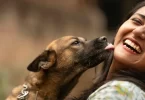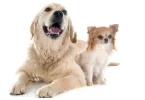If you’ve noticed your dog pawing at you more than usual, you’re not alone. This behavior can be puzzling, especially when your furry friend seems particularly insistent. Understanding why your dog engages in this behavior can deepen your bond and enhance your communication with them.
Understanding Dog Communication

Dogs are naturally expressive creatures, and they communicate in various ways, including body language and vocalizations. Pawing is one of those signals that can carry different meanings depending on the context. Observing the situation can provide valuable insights into what your pup is trying to convey.
Common Reasons for Pawing
- Seeking Attention One of the most straightforward explanations for a dog’s pawing is that they want your attention. Dogs thrive on interaction, and if they feel neglected or bored, they may paw at you as a gentle reminder that they’re ready for some quality time.
- Desiring Affection Many dogs use pawing as a way to seek physical affection. If you notice your Bordeaux nudging you with their paw, it might simply mean they want a scratch or a cuddle. It’s their way of saying, “Hey, I love you!”
- Expressing Hunger or Thirst If your dog is consistently pawing at you, they might be trying to tell you it’s time for a meal or that their water bowl is empty. Dogs have a natural sense of timing when it comes to their routines, and they’ll let you know when they need something.
- Discomfort or Pain Sometimes, a dog may paw at you if they’re feeling uncomfortable or in pain. If this behavior is new and persistent, it’s important to check for any signs of injury or discomfort. A visit to the vet can help rule out any underlying health issues.
- Instinctual Behavior Dogs have natural instincts that drive certain behaviors. Pawing can be a part of their instinct to dig or burrow, which is more pronounced in some breeds. If your dog seems to paw at you in this manner, it might simply be an instinctive urge.
Training Tips for Pawing Behavior

If your dog’s pawing becomes excessive, you can implement some dog training tips to help manage it. Here are a few ideas:
- Redirect Attention: When your dog paws at you, redirect their energy towards a toy or activity. This can help reinforce positive behaviors while providing an outlet for their enthusiasm.
- Teach Commands: Basic obedience commands can be beneficial. Teaching your dog to sit or stay when they want attention can help reduce constant pawing and foster better communication.
- Reward Calm Behavior: If your dog approaches you without pawing, reward them with praise or treats. This encourages them to seek your attention in a more polite manner.
Understanding Dog Behavior Meaning
Every dog has a unique personality, and their behaviors can vary widely. Understanding your dog’s behavior meaning requires patience and observation. Pay attention to the context in which your dog paws at you. Is it during playtime, when you’re busy, or when you’re relaxing? This can give you clues about their emotional state.
Where to Pet a Dog for Comfort
Knowing where to pet a dog can enhance your connection and help calm them down if they seem anxious. Most dogs enjoy being petted on the chest, back, and behind the ears. If your dog approaches you with a paw, try offering gentle pets in these areas. This can provide reassurance and create a more relaxed atmosphere.
Paw Care Matters
While discussing pawing, it’s also crucial to consider paw care. Dogs’ paws are exposed to various elements, and keeping them healthy is essential for their overall well-being. Regularly check your dog’s paws for cuts, debris, or signs of irritation. Keeping their nails trimmed and pads moisturized can also prevent discomfort and encourage happy behavior.
Exploring Ideas for Dogs
If you’re looking for ways to keep your dog engaged and reduce excessive pawing, consider these ideas:
- Interactive Toys: Providing toys that stimulate your dog mentally can help distract them from seeking constant attention.
- Training Sessions: Incorporate short training sessions into your routine. This not only reinforces good behavior but also provides an outlet for their energy.
- Quality Time: Spend dedicated time each day playing with your dog. Activities like fetch or tug-of-war can satisfy their need for interaction and reduce the urge to paw at you.
Conclusion
Understanding why your dog is pawing at you constantly can deepen your connection and improve your communication. Whether they’re seeking attention, affection, or expressing discomfort, paying attention to their cues is essential. By implementing effective training tips and ensuring their needs are met, you can foster a happier and more harmonious relationship with your furry friend.
So the next time your dog nudges you with their paw, take a moment to consider what they might be trying to tell you. Your understanding can make all the difference in their world.





